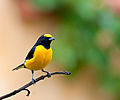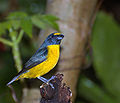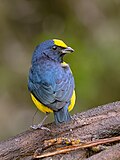
The true finches are small to medium-sized passerine birds in the family Fringillidae. Finches generally have stout conical bills adapted for eating seeds and nuts and often have colourful plumage. They occupy a great range of habitats where they are usually resident and do not migrate. They have a worldwide native distribution except for Australia and the polar regions. The family Fringillidae contains more than two hundred species divided into fifty genera. It includes the canaries, siskins, redpolls, serins, grosbeaks and euphonias, as well as the morphologically divergent Hawaiian honeycreepers.

The rosefinches are a genus, Carpodacus, of passerine birds in the finch family Fringillidae. Most are called "rosefinches" and as the word implies, have various shades of red in their plumage. The common rosefinch is frequently called the "rosefinch". The genus name is from the Ancient Greek terms karpos, "fruit", and dakno, "to bite".
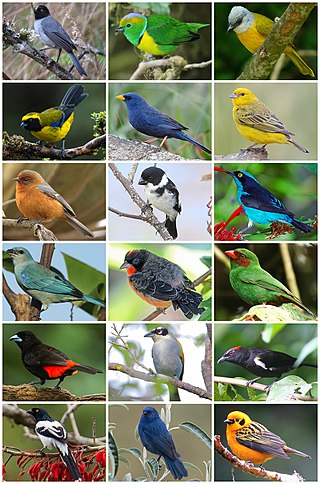
The tanagers comprise the bird family Thraupidae, in the order Passeriformes. The family has a Neotropical distribution and is the second-largest family of birds. It represents about 4% of all avian species and 12% of the Neotropical birds.

Anselme Gaëtan Desmarest was a French zoologist and author. He was the son of Nicolas Desmarest and father of Eugène Anselme Sébastien Léon Desmarest. Desmarest was a disciple of Georges Cuvier and Alexandre Brongniart, and in 1815, he succeeded Pierre André Latreille to the professorship of zoology at the École nationale vétérinaire d'Alfort. He was elected to the American Philosophical Society in 1819 and to the Académie Nationale de Médecine in 1820.

Described by French naturalist Anselme Gaëtan Desmarest in 1826, the genus Calyptorhynchus has two species of cockatoos. They are all mostly black in colour, and the taxa may be differentiated partly by size and partly by small areas of red, grey, and yellow plumage, especially in the tail feathers. Studies based on the mitochondrial DNA 12S gene fragment suggested that other sexually dichromatic species, the gang-gang cockatoo and the cockatiel may be the closest living relatives of Calyptorhynchus. However, subsequent studies, including more genes confirm the morphological taxonomy with the gang-gang cockatoo most closely related to the galah, within the white cockatoo group, and with the cockatiel as a third distinct subfamily of cockatoos.
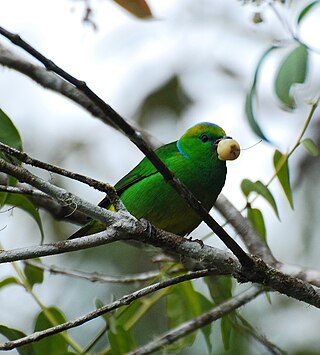
Euphoniinae is a subfamily of finches endemic to the Neotropics. It contains two genera, Euphonia and Chlorophonia.

Chlorophonia is a genus of finches in the family Fringillidae. The Chlorophonias are endemic to the Neotropics. They are small, mostly bright green birds that inhabit humid forests and nearby habitats, especially in highlands.

The white-bellied canary is a species of finch in the family Fringillidae. It is found in Ethiopia, Kenya, Somalia, South Sudan, Tanzania, and Uganda. Its natural habitat is dry savanna.
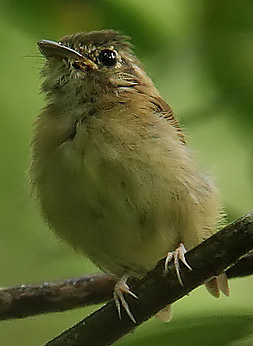
The spadebills are a genus, Platyrinchus, of Central and South American passerine birds in the tyrant flycatcher family Tyrannidae. They have broad, flat, triangular bills.

The golden-sided euphonia is a species of bird in the family Fringillidae. It is found in northern Brazil, French Guiana, Guyana, Suriname and eastern Venezuela. Its natural habitat is subtropical or tropical moist lowland forest.

The purple-throated euphonia is a songbird species in the family Fringillidae. It was formerly placed in the Thraupidae.
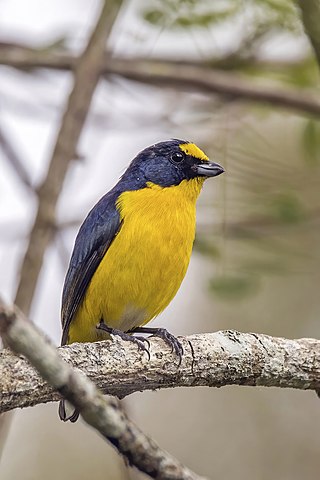
The yellow-throated euphonia is a species of songbird in the family Fringillidae. It is found in southeastern Mexico and throughout Central America with its range stretching from Belize south to western Panama. It inhabits primarily both humid and dry regions where it prefers the forest edge, open woodland, and shaded plantations. It has two subspecies, the nominate subspecies Euphonia hirundinaceahirundinacea and Euphonia hirundinacea gnatho. This finch is a small bird with pointed wings and a short bill and short tail. Males of this species have dark glossy blue-black upperparts excluding a yellow forecrown, and bright yellow underparts, while females have olive green upperparts and whitish-gray breast and lower parts. It has a shrill song that alternates between high-pitched and moderately pitched and appears to be able to mimic some calls of other birds.

The Hispaniolan euphonia is a bird species in the finch family, Fringillidae that is endemic to the island of Hispaniola in the Caribbean.

The Trinidad euphonia is a species of bird in the family Fringillidae. It is common in northern Colombia and northern Venezuela and uncommon to rare on the Caribbean island of Trinidad. Like all euphonias, it is small, stocky, and short-tailed; unlike some, it is sexually dimorphic. The male is glossy blue-black on the head, back, throat, and upper breast, with a bright yellow forehead and crown, and bright yellow underparts. The female is olive-green above and yellow-olive below, with a grayer patch running down the center of her breast and abdomen, and bright yellow undertail coverts. Its calls are high-pitched, plaintive whistles: the two most common are a single-pitched, double-noted "pee pee" or "tee dee", or a rising, double-noted "puwee", "cooleee" or "duu dee". Its song is a short, jumbled mix of musical and nonmusical notes.

The white-crested spadebill is a species of passerine bird in the tyrant flycatcher family Tyrannidae. It is found in Bolivia, Brazil, Colombia, Ecuador, French Guiana, Guyana, Peru, Suriname, and Venezuela. Its natural habitat is subtropical or tropical moist lowland forests.

The Brazilian tanager is a species of bird in the family Thraupidae. It is endemic to eastern Brazil and far northeastern Argentina, occurring in the coastal region from Paraíba and southwards to Santa Catarina and Misiones.

Ramphocelus is a Neotropical genus of birds of the tanager family. They have enlarged shiny whitish or bluish-grey lower mandibles, which are pointed upwards in display. However, this is greatly reduced in the females of most species. Males are black and red, orange or yellow, while females resemble a duller version of the males, or are brownish or greyish combined with dull red, orange or yellowish.
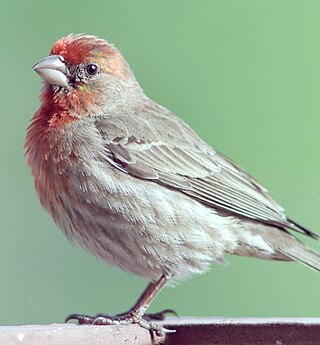
The American rosefinches that form the genus Haemorhous are a group of passerine birds in the finch family Fringillidae. As the name implies, various shades of red are characteristic plumage colors of this group. They are found throughout the North American continent.

Spinus is a genus of passerine birds in the finch family. It contains the North and South American siskins and goldfinches, as well as two Old World species.




